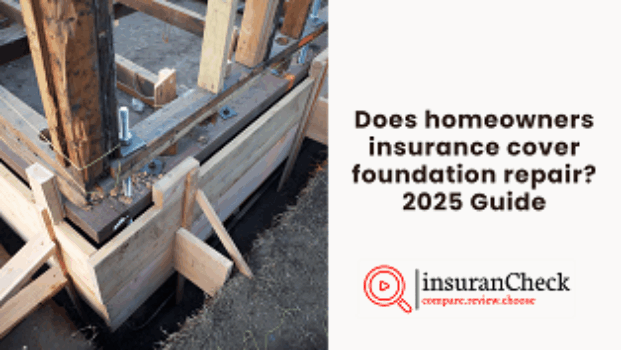Consider finding spaces in your walls, floors that are not flat, or suddenly jammed doors. All of these acts as early warnings of the potential grave issue lurking beneath your building—foundation damage. It is not only a structural inconvenience; it causes a financial crisis, and the expenses for the repair can range from ten to several tens of thousands of dollars. The main thing is: Does homeowners insurance cover foundation repair?
Almost all Americans mistakenly think their policy covers the foundation before knowing they will be paying for it. In this piece, we analyze what is generally covered by homeowner’s insurance, when it might pay for foundation repairs, and how you can rescue your greatest investment—your home—before the salvage is no longer possible.
Table of Contents
What is foundation damage in homes?
The place where the house is supported is the foundation. So, when the foundation goes wrong, everything above it will have problems; that is the literal meaning. If you know the reasons for the damage, you can spot it earlier and prevent the expense of bills mounting up too much troubling repair work.
1. Soil Movement and Shifting
Soil can change in height. Some dirt gets moist and swells up, then dries out and shrinks. This can crack the houses. That did happen to me. The dirt might push the house down or up. 1 out of 4 houses has problems because of this.
2. Water Damage and Poor Drainage
Water is bad for houses. If pipes break or rain does not drain away, water washes the dirt away under the house. There can be holes that the house sinks into. Also there were bladder damage. Gutters and the ground must make the water go away.
3. Tree Roots and Vegetation
Big trees that are close to the house might be dangerous too. Roots look for water and disturb the soil. Sometimes they even get into cracks and make them bigger. I have had my share of pushy tree roots pulling move my house around from its spot.
4. Earthquakes and Natural Disasters
Houses near fault lines are in danger during quakes. Even small ones can cause cracks inside that grow. Unlike those that are easy to see, these secretly do more damage over time.
5. Poor Construction or Substandard Materials
At times, foundation problems can be due to how a house is built. Weak materials, not checking the soil enough, or hurrying the building process can lead to a bad foundation. Later on, it might cost a lot to fix these big issues.
How Much Does Foundation Repair Typically Cost in the U.S.?
In the U.S., it costs $2,000 to $8,100 to fix foundation problems. The average cost is about $5,166. But some jobs cost more than this range, while others could be cheaper.
For just small cracks or tiny shifts, only a few hundred dollars might be needed. In contrast, large sinking and extensive moving foundations sometimes need underpinning or hydraulic piers—adding up to costs that reach twenty thousand dollars or more.
The soil type under a home and local labor rates also play a part in deciding how much will be spent on repairs. Homes built in regions with lots of flooding or expansive clay soil usually require costlier fixes because of recurring issues.
It pays off big time to get an early inspection and fix any problems found from the start. The sooner these are dealt with, the cheaper they are compared to later major repairs.
Does Homeowners Insurance Cover Foundation Repairs?
The answer is no, not usually. Standard homeowner’s insurance does not pay for wear and tear, settling, or bad building design. But if the foundation damage results from a sudden mishap that is covered, like a burst pipe or fire, insurance may help pay for the repairs.
Homeowner’s insurance covers sudden accidents like burst pipes, fires, and vandalism that cause damage to your foundation. For instance, the home insurance policy covers a pipe bursting in the foundation and flooding it.
However, foundation issues that happen over time due to shifting soil, leaking water, tree roots, earthquakes, or floods are not covered unless special riders or endorsements, such as earthquake or flood insurance, are included in the policy.
Read your policy details or talk with your agent to discover what is or is not covered. Don’t wait until something happens; knowing your coverage now will help you respond effectively later.
How Can Homeowners Better Protect Their Foundation and Wallet?
Consider the foundation of your home as the main support. It needs constant upkeep and vigilance regarding money issues. The key to avoiding expensive repairs is controlling the moisture surrounding your property. Direct your gutters and downspouts away from the base. Ensure that water does not gather near the walls by sloping the ground away.
At areas prone to flooding, you might want sump pumps or French drains to move water away. Frequently check for cracks on the foundation after heavy rains or quakes since early detection avoids big issues later. Do not plant big trees too close if roots creep under the foundation.
Ask the insurance agent what special coverage could help you if disaster strikes, including earthquakes and floods, that normal policies do not cover. Such riders are lower-cost than repairing the damage out of your pocket.
Conclusion
Damage to the foundation of a house is bad, not good, but this can be avoided, as well as the insurance for some cases that might occur. The standard insurance for homeowners does not cover most problems related to foundations. You will be safe if you know the dangers, maintain your home as necessary, and get insurance when needed. It is good to have knowledge of these things for the sake of your home and money.







